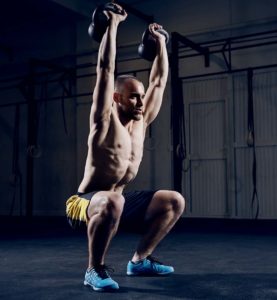If you ballistische Satze incorporate it into your workout, and your progress will lift you off the ground!
How fast do you push the weight up off your chest in the normal bench press? If you want to calculate that in seconds, then save yourself the trouble, because the correct answer is: "As fast as I can!"
Let's say you want to bench press a set of six, eight, or ten reps. If you're really using a weight that allows you to do a maximum of six, eight, or ten reps (that is, your target weight doesn't allow you to do any more repetitions), then push the weight up as quickly as possible on the upward movement, at least the first third the range of motion. If you don't believe this, then pay attention to it the next time you bench press.
GO BEYOND THE POINT OF FAILURE
So what's the problem? Well, consider the point of failure on that set of bench presses. You know exactly which point I mean the point at which repetition threatens to fail. What do you need to do so that you can overcome this point and reach the next level of training? Do more training in the same way? Of course not! One of the keys to overcoming training plateaus, failure points, and performance limits is to train the body to activate the FT fibers. Because they have the greatest potential for strength and muscle building. And ballistic, explosive training forces the muscles to adapt quickly and vigorously to the contractions. The FT fibers are trained to be in develop a lot of strength in a short time. Just as your maximum weight, which allows you to do six, eight, or ten repetitions, will keep increasing, so will your target muscles.

DO NOT SLOW DOWN THE REPEAT SPEED
I mentioned earlier that in the first third of the range of motion, you are pushing the weight up as fast as possible. But what happens in the other two thirds? Well, in these two thirds the weight is actually moved more slowly so that the dumbbell sticks to the hands. And now that's the good thing about ballistischen Training: You can make the dumbbell fly with explosive movements! And during exercises with pure body weight, the hands can completely leave the floor, such as explosive push-ups. Or the feet lift off the floor with jump squats. So with ballistic training, you don't need to worry about the weight stopping. Instead, just do explosive movements and leave them like that fire as many FT fibers as possible.
Since, of course, I don't want you to be one schwere Langhantel Throwing it in the air, ballistic training is best done on machines.
For example, on the multi-press, with high security bolts and a reliable training partner. You can also hook dumbbells in your hands for jump squats and even wear a weight vest for push-ups.
TRAINING WEIGHT ADVICE
So how high should the training weight be? Research has shown that exercising at around 30 to 50 percent of one's maximum develops optimal strength. So this is your used weight. For example, if your bench press singles max is 150 pounds, your ballistic reps should be between 40 and 60 pounds. This weight is not only best suited for strength development, but is also ideal for safety reasons for you and the other athletes around you.
Beim ballistischen Training brauchen Sie sich keine Sorgen zu machen, dass das Gewicht zum Stoppen kommt. Stattdessen absolvieren Sie einfach explosive Bewegungen und lassen dabei so viele FT-Fasern wie möglich feuern.“
If you are struggling with the last few reps, still push the bar up as fast as you can - even if it's moving relatively slowly.
And finally you train at ballistischen Training not to failure. Stick to four to five sets of three to five repetitions per set - even if you think you could go on. Again, the advantages of ballistic training are in the muscle fiber recruitment pattern!
So if you go back to your usual rep schedule and exercises, you will find yourself pushing the weight much more explosively through the range of motion. And after a few weeks vigorous ballistic training Your answer “As fast as I can” takes on a completely different meaning.
BALLISTIC TRAINING SAMPLE EXERCISES
 Do these exercises for specific muscle groups at 30 to 50 percent of your single maximum each day of training, four sets and five explosive repetitions per set.
Do these exercises for specific muscle groups at 30 to 50 percent of your single maximum each day of training, four sets and five explosive repetitions per set.
- Sprung-Kniebeugen
- Box jumps
- explosive pushups
- Expensive bench press on the multi press
- one-armed rowing on the multi-press
- Front pressing on the multi-press
- Jump squats with dumbbells
- explosive tight bench press on the multi press. Barbell curls on the multi press
WHAT IS BALLISTIC TRAINING?
No matter what exercise you do, push the weight up explosively, that is, as quickly and forcefully as you can. When you do exercises such as bench press and shoulder press on the multi press, the bar will actually come off your hands. And doing squats will raise your feet off the floor.
- Use a weight that is about 30 to 50 percent of your ones maximum.
- Rest at least two minutes between ballistic sets to ensure that you fully recover after each set.
- For best results, do the ballistic exercises early in the session, when you are fresh.
- Each rep of a ballistic set should be done as explosively as possible without slowing down. Because this is how you achieve the greatest possible recruitment of FT fibers.
- If you include ballistic sets for multiple exercises in your program, then you will only be training with these explosive sets for a few weeks. Then continue training normally for a few weeks before integrating ballistic training into your workouts again.

A comment
Comments are closed.